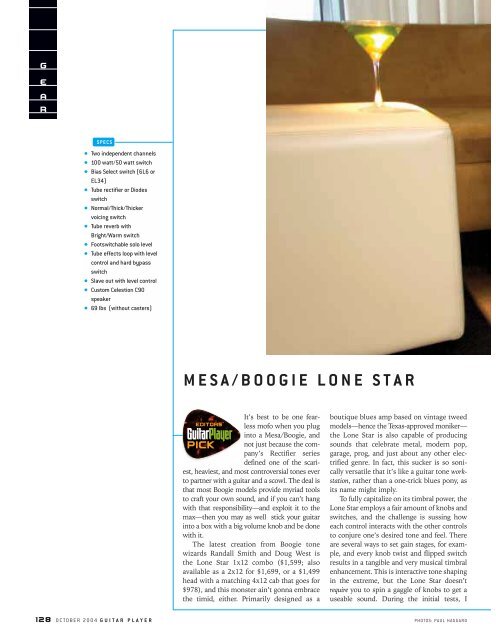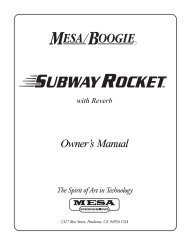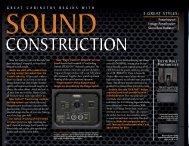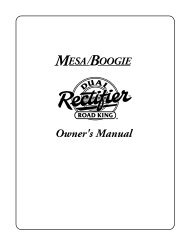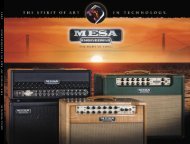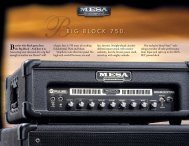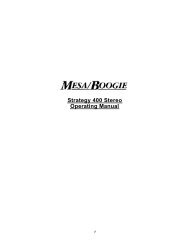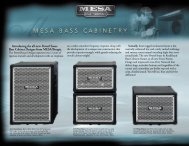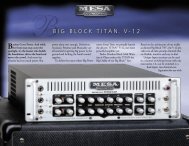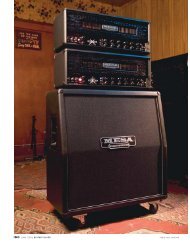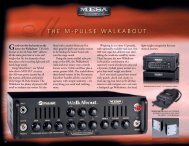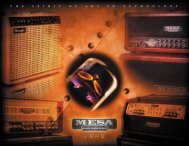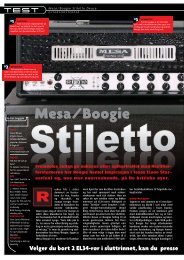Create successful ePaper yourself
Turn your PDF publications into a flip-book with our unique Google optimized e-Paper software.
GEARSPECS• Two independent channels• 100 watt/50 watt switch• Bias Select switch (6L6 orEL34)• Tube rectifier or Diodesswitch• Normal/Thick/Thickervoicing switch• Tube reverb withBright/Warm switch• Footswitchable solo level• Tube effects loop with levelcontrol and hard bypassswitch• Slave out with level control• Custom Celestion C90speaker• 69 lbs (without casters)<strong>MESA</strong>/<strong>BOOGIE</strong> <strong>LONE</strong> <strong>STAR</strong>It’s best to be one fearlessmofo when you plugEDITORS’into a Mesa/Boogie, andPICK not just because the company’sRectifier seriesdefined one of the scariest,heaviest, and most controversial tones everto partner with a guitar and a scowl. The deal isthat most Boogie models provide myriad toolsto craft your own sound, and if you can’t hangwith that responsibility—and exploit it to themax—then you may as well stick your guitarinto a box with a big volume knob and be donewith it.The latest creation from Boogie tonewizards Randall Smith and Doug West isthe Lone Star 1x12 combo ($1,599; alsoavailable as a 2x12 for $1,699, or a $1,499head with a matching 4x12 cab that goes for$978), and this monster ain’t gonna embracethe timid, either. Primarily designed as aboutique blues amp based on vintage tweedmodels—hence the Texas-approved moniker—the Lone Star is also capable of producingsounds that celebrate metal, modern pop,garage, prog, and just about any other electrifiedgenre. In fact, this sucker is so sonicallyversatile that it’s like a guitar tone workstation,rather than a one-trick blues pony, asits name might imply.To fully capitalize on its timbral power, theLone Star employs a fair amount of knobs andswitches, and the challenge is sussing howeach control interacts with the other controlsto conjure one’s desired tone and feel. Thereare several ways to set gain stages, for example,and every knob twist and flipped switchresults in a tangible and very musical timbralenhancement. This is interactive tone shapingin the extreme, but the Lone Star doesn’trequire you to spin a gaggle of knobs to get auseable sound. During the initial tests, I128 OCTOBER 2004 GUITAR PLAYER PHOTOS: PAUL HAGGARD
plugged in a Les Paul and a Stratocaster, fiddledmomentarily with the Gain and Mastervolume on each of the Lone Star’s two channels,and achieved some damn fine clean andoverdriven sounds with no fuss.So here’s the deal for cowardly liontypes: The Lone Star is indeed an over-thetopsonic option box, but it can also be aplug-in-and-play machine, and however youchoose to employ the Lone Star’s armament,it will always be a handmade, nearbulletproof, boutique-styled amp thatsounds magnificent. Still scared?C O N S T R U C T I O NThe Lone Star is constructed like a RollsRoyce. The attention to detail is uncanny,from the near flawless application of the fabblue tolex (a few slits are visible at some corners)right down to the wheels. But this isn’tall about beauty—the Lone Star is one toughmother, as well. Reenacting a road tragedyfrom my touring days, I let the amp roll downa slight loading-dock incline and smack into adumpster—four times. After brushing somedirt from its hide, the amp performed as ifnothing had happened, and there were nonoticeable rattles, loose screws, or otherimpact-induced nastiness. I think I could havetossed a concussion grenade into the openback, and the Lone Star would still work justfine. This bronco seems to be absolutelyindestructible, and it’s definitely more robustthan some of my other amps that have neverfailed throughout years of gigging.O P E R A T I O NI won’t bore you with operational details youcan glean from the user’s manual, but youshould be aware of the Lone Star’s multiplegain/timbral stages. In addition to the obviouspreamp gain and master controls, bothchannels let you choose 50-watt or 100-wattoperation. This means you can configure onechannel with uber headroom (100 watts),and downshift the other for some maxedout,overdriven snarl (50 watts). There’s alsoa power switch that toggles between Off,Tweed (for a looser response and overdrive atlower volumes), and On (for full cowabungaheadroom). A global Output sets the overallvolume, and a Solo knob lets you dial inGUITAR PLAYER OCTOBER 2004 129
some boost, which is accessible only viafootswitch. Channel 2 offers a three-positionvoicing switch that provides Normal (cleanwith shimmering highs), Thick (throaty mids),and Thicker (maximum saturation) modes.You can also remove the lead circuit onChannel 2 to elicit a vintage “cranked” tone.The back panel’s bias switch lets you easilyswap the included 6L6 power tubes for EL34s(if you desire some vintage British crunch), andthere’s also an innovative Diodes/Tube RectifierTracking switch. When in Tracking mode, a 5U4rectifier tube is automatically engaged whenyou run at 50 watts to produce a groovy powersag. In Diodes mode, a solid-state rectifier deliversoptimum headroom and a tighter attack.T H E S O U N DSome people dig the high-end gronk (somecall it “nasal”) associated with many Boogies,and some don’t, but that little debate isn’t anissue with the Lone Star, because that timbreis gone. Treble frequencies simply blossominto the heavens, and I couldn’t find a tonethat wasn’t absolutely musical. The overdrivetones definitely have an old-school vibe—you’ll have no problem dialing in the thick,syrupy sustain of a Paul Kossoff, the raunchysnap and gristle of a Malcolm Young, or mostany tone in between the Small Faces and theSex Pistols. Clean settings can deliver chunkymid girth and sparkling highs, and if asmidgeon of personality is missing, evokingsome truly aggro spank is simply a matter ofswitching to EL34s. And while the Lone Starisn’t designed to uncork so-called “modernrock” sounds, I was very pleased with its liquidand soaring high-gain tones—very coolfor ambient stylings, detuned riffs, heavyriddims, and spasms of inspired lunacy.The only thing that may be strange for someplayers is that a timed mute with delay kills thereverb for about three seconds when you switchbetween channels. Boogie patented this featureto prevent “reverb backwash” when, say,switching from a raging lead tone to a rhythmsetting. While this makes perfect sense—as itprevents situations where “ghosted” reverberantnotes from your solo make all kinds of messaround your very sensitive verse melody—someof the GP editors weren’t comfortable with thereverb going away and then sneaking back.The Lone Star can deliver so many incredibleshades of tone that where you take theamp is totally up to you. But wherever yougo, rest assured the Lone Star will deliverenough lows, mids, highs, headroom, sag,and overdrive to match your sonic aspirations.The Lone Star is one fabulous boutique-oriented,multifaceted, versatile, tonespewingbeauty, and it absolutely earns anEditors’ Pick Award. g
ZOOMFront panel: Controls are clearly arranged—although it’s near impossible to see the tinylabels while standing.Back panel: The Lone Star provides dedicatedlevelGEARINSTANTGRATIFICATION<strong>MESA</strong>/<strong>BOOGIE</strong><strong>LONE</strong> <strong>STAR</strong> 1X12WHO’S IT FOR?Tone zealots.KUDOSAwesome toneshapingpower.Sounds that trulyastound. Tougherthan The Rock, VinDiesel, and the Hulkcombined. Entirelead circuit can bebypassed.CONCERNSHeavy. Some usersmay not dig thetimed mute thatkills reverb forthree seconds whenswitching betweenchannels.PRICE$1,599 retailCONTACTMesa Engineering,(707)778-6565;mesaboogie.comZOOMThe Lone Star’s innards are rugged and cleanlylaid out.


